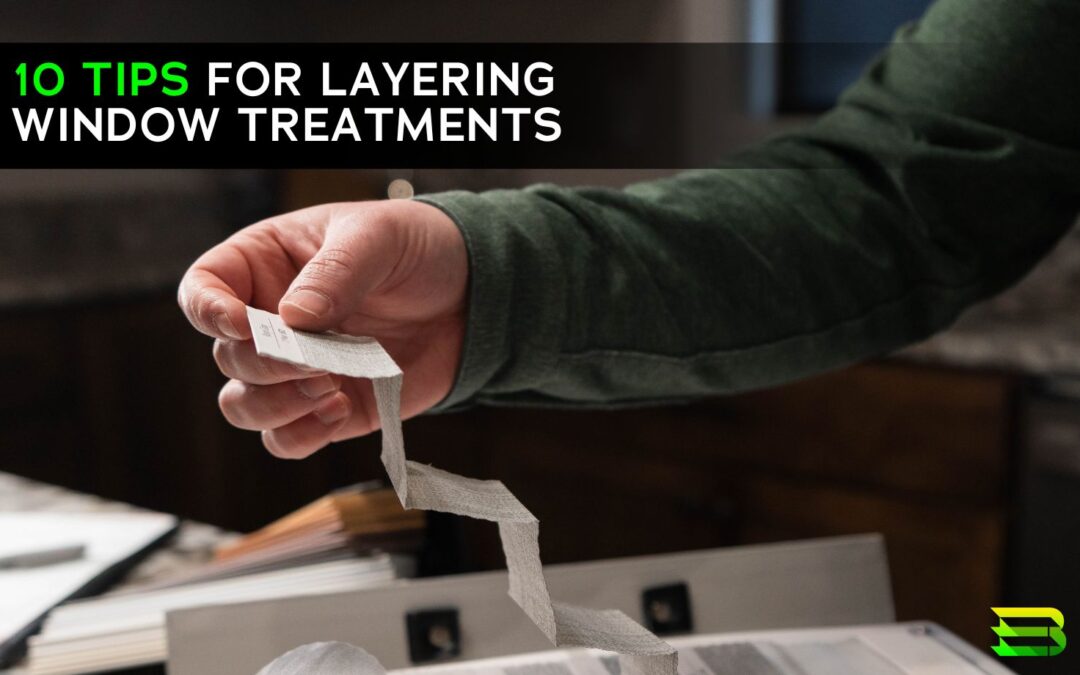It’s spring, and the redecorating bug is hitting homeowners everywhere with the urge to update and redesign their living spaces with new furniture, wall colors, and decor. No new look would be complete, however, without attention to your window treatments. Refresh your old, tired valances with the newest layered look, and you can easily add style, warmth, and functionality to any space. Layering window treatments is a popular technique that allows you to combine different styles, textures, and colors to create a unique aesthetic while also offering practical benefits. Best Blinds & Awnings offers a variety of custom window blinds and shades that can be layered beautifully with your own vintage or newly purchased textiles and other treatments to give your room a style infusion. Whether you want to enhance privacy, control light, or simply add a decorative touch to your windows, here are ten tips for layering window treatments that add visual appeal and functionality while reflecting your unique style.
1. Mix Different Textures
One key to successful window treatment layering is mixing different textures. Combining lightweight fabrics like sheer curtains with heavier drapes adds depth and visual interest to your windows. Pair coarse weaves with smooth silks, gently gathered linen with sharp vertical blinds, or hardwood with soft fabric to accentuate the best features of both. The contrast between two textures creates a dynamic look that can make a room feel more inviting and cozy.
2. Consider Functionality
When layering window treatments, it’s important to consider the functionality of each layer. For example, if you’re layering curtains over blinds or shades, make sure the curtains are easy to open and close to allow maximum light control and privacy. Consider using blackout curtains as the inner layer for bedrooms or media rooms where being able to block out light when necessary is essential.
3. Use Complementary Colors
Choosing window treatments in complementary colors can help create a cohesive look. Begin with a neutral base layer, such as white or beige blinds, and add a burst of color with the top layer. This approach can help tie the room’s color scheme together and create a harmonious look.
4. Play with Patterns
You may think mixing patterns is a no-no in interior decorating, but that’s not true. The trick is to make sure the patterns complement each other and don’t overwhelm the space. For example, you could pair a floral patterned curtain with a striped valance for a fun and eclectic look. If you use one big, bold, busy pattern, use solid colors or a small, repeating pattern for other layers. If most of your furnishings are solid colors, a vivacious print can make your windows the dramatic focal point of your room.
5. Add Valances or Cornices
Valances or cornices add a finishing touch to your layered window treatments and hide the hardware for a cleaner look. Consider using a valance or cornice in a contrasting color or pattern to increase visual interest. The elegance of a well-chosen cornice instantly elevates the impact of your window decor.
6. Layer with Blinds or Shades
Best Blinds’ unique, high-quality blinds and shades provide a perfect base layer when assembling wow-worthy window treatments. They offer privacy and light control while also serving as a backdrop for your curtains or drapes. Choose blinds or shades in a neutral color that complements your curtains for a cohesive look, and then accent with fabrics or panels of your choosing.
7. Consider Window Size
Your window’s dimensions can also influence how you layer your window treatments. For small windows, avoid heavy fabrics that can overwhelm the space. Instead, opt for lightweight materials that allow natural light to filter through. For larger windows, employ multiple layers to add depth and dimension.
8. Experiment with Lengths
Playing with the lengths of your window treatments can create a dramatic effect. For example, you could layer short curtains over longer ones to create a cascading effect. When done well, this effect can enhance the decorative impact of your windows and draw the eye upward, making the room feel larger.
9. Use Tiebacks or Holdbacks
Tiebacks or holdbacks can be used to hold back the top layer of curtains and showcase the layers underneath. Gathering heavy drapes to the side to frame sheer blinds, for example, creates a more open and airy feel in your space while also allowing more natural light to enter. Choose tiebacks or holdbacks in a material that complements your curtains to complete the look.
10. Seek Professional Advice
When in doubt, seek the advice of a professional designer or window treatment specialist. They can help you choose the right window treatments for your space and provide guidance on how to layer them effectively. If you start with properly fitted blinds or shades from Best Blinds & Awnings, you will present a beautiful canvas for a professional to build upon. Interior designers can help you select fabrics, hues, and patterns that mix well with your existing decor and create the look you desire.
To start the process of giving your windows a facelift, contact Best Blinds & Awnings today for a consultation. Layering window treatments is a versatile and practical way to enhance your windows’ beauty while increasing their functionality. By mixing different textures, colors, and patterns, you can design a window treatment that is more than the sum of its parts, complementing your decor and elevating the ambiance of your home. Whether you want to enhance privacy, control light, or simply add a decorative touch to your windows, these tips will help you achieve the perfect layered window treatments for your space.

